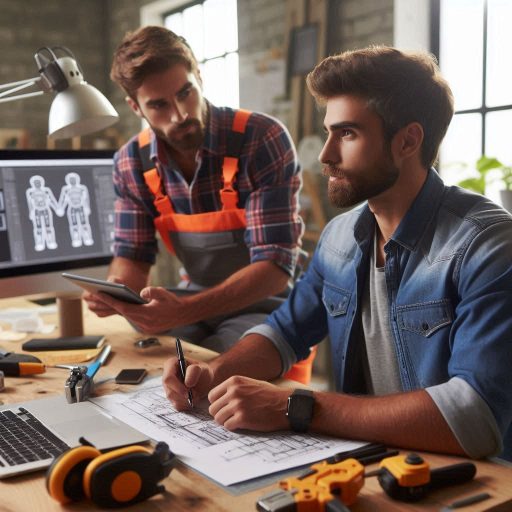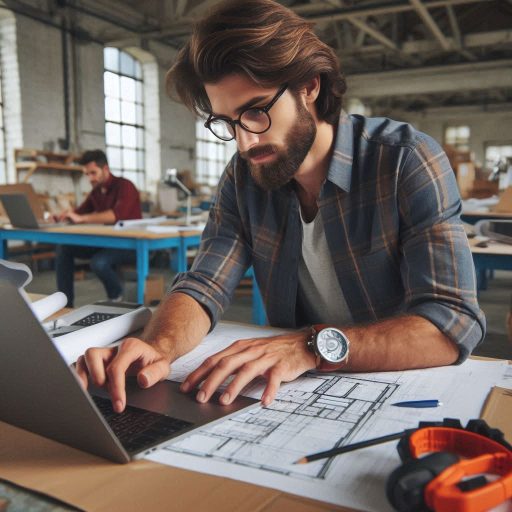Introduction
Industrial Design
Industrial design involves creating products that are both functional and visually appealing.
It combines art and engineering to enhance user experience.
Designers focus on improving the form, function, and usability of products.
Their work spans a wide range of industries, from consumer goods to technology and furniture.
Industrial design ensures that products are practical, safe, and attractive.
Importance of Balancing Aesthetics and Function in Industrial Design
Balancing aesthetics and function is crucial in industrial design.
Aesthetic appeal attracts users and makes products desirable.
Functionality ensures that products meet practical needs and perform effectively.
Achieving this balance requires careful consideration of user experience, materials, and manufacturing processes.
Good design harmonizes beauty with usability, enhancing both form and function.
Preview of Main Points to Be Discussed
In this session, we will explore several key aspects of balancing aesthetics and function.
First, we‘ll discuss the importance of integrating both elements into design.
Next, we‘ll examine how to address design challenges when balancing these aspects.
We‘ll also highlight examples of successful designs that achieve this balance.
Finally, we‘ll offer strategies for maintaining harmony between aesthetics and functionality in your own projects.
The role of aesthetics in industrial design
Importance of Aesthetics in Creating a Visually Appealing Product
Aesthetics are crucial in industrial design as they determine the visual appeal of a product.
A well-designed product not only attracts attention but also creates a memorable first impression.
The use of color, form, texture, and proportion in a product’s design can significantly enhance its appeal.
Aesthetics play a vital role in setting a product apart from competitors.
Unique and attractive designs can differentiate a product in a crowded market, making it more recognizable.
This visual distinction helps in building brand identity and establishing a product‘s presence.
Incorporating aesthetic elements into a product design also contributes to its overall user experience.
A product that looks good can evoke positive emotions and foster a stronger connection between the user and the product.
This emotional response is a key factor in encouraging consumer preference and loyalty.
How Aesthetics Can Affect Consumer Perception and Purchase Decisions
Aesthetics significantly influence consumer perception and purchase decisions.
Consumers often make snap judgments based on a product‘s appearance.
An attractive design can lead to higher perceived value and quality, making the product more appealing to potential buyers.
Product aesthetics also impact consumer confidence.
A visually appealing product can suggest careful attention to detail and craftsmanship.
This perception of quality can encourage consumers to choose it over less attractive alternatives.
Moreover, aesthetics can drive brand recognition and preference.
A product with a distinctive design can become iconic, making it easier for consumers to remember and identify.
Consistent and appealing aesthetics help build a strong brand image, leading to increased consumer trust and loyalty.
Examples of Products That Successfully Incorporate Aesthetics into Design
Several products demonstrate how aesthetics can be successfully integrated into industrial design.
The Apple iPhone is a prime example, with its sleek, minimalist design that combines functionality with visual elegance.
Its clean lines and premium materials contribute to its high perceived value and widespread appeal.
Another example is the Dyson Airblade hand dryer.
Its futuristic design not only looks modern but also enhances user experience through its innovative technology.
The product‘s aesthetic appeal reflects its advanced functionality and sets it apart from conventional hand dryers.
The Herman Miller Aeron chair is also notable for its aesthetic and ergonomic design.
Its distinctive appearance combines with superior comfort, making it a popular choice in both office and home settings.
The chair‘s design elements contribute to its reputation as a high-quality, desirable product.
Balancing aesthetics and function is essential in industrial design.
Aesthetic appeal enhances the visual attractiveness of a product, impacting consumer perception and purchase decisions.
Successful examples like the iPhone, Dyson Airblade, and Herman Miller Aeron chair highlight the importance of integrating aesthetics into design.
By carefully considering both visual appeal and functionality, designers can create products that not only perform well but also captivate and satisfy consumers.
Read: Top Skills Needed for Art Educators and Instructors
The importance of function in industrial design
What Constitutes Good Functionality in Design
Good functionality in design refers to how effectively a product performs its intended tasks.
It involves usability, efficiency, and reliability.
A well-designed product should solve a problem or meet a need without unnecessary complexity.
Good functionality ensures that users can operate the product intuitively and without frustration.
Key aspects of functionality include ease of use, ergonomics, and durability.
A product should be comfortable to use and fit naturally into users’ hands or environments.
Durability ensures that the product withstands regular use and maintains performance over time.
Additionally, a functional design minimizes the need for frequent maintenance or repairs.
Effective functionality also considers the integration of features that enhance the user experience.
These features should be practical and contribute to the overall performance of the product.
The design must balance form and function, ensuring that every element serves a purpose and contributes to the product’s effectiveness.
How Functionality Enhances User Experience
Functionality significantly enhances the user experience by making products more intuitive and efficient.
When a product performs its intended function well, it meets user needs effectively and enhances satisfaction.
An intuitive design allows users to interact with the product seamlessly, reducing the learning curve and improving usability.
For example, a well-designed ergonomic chair supports proper posture and reduces physical strain, making it more comfortable for long periods of use.
This functionality enhances the user experience by promoting health and comfort, which contributes to overall satisfaction.
Furthermore, functional designs often lead to improved efficiency.
Products that streamline processes or simplify tasks make users‘ lives easier and more productive.
For instance, a multi-tool designed with various integrated functions eliminates the need for multiple separate tools, saving time and space.
Examples of Products That Prioritize Function Over Aesthetics
Several products prioritize function over aesthetics, demonstrating that effective design often puts usability first.
One notable example is the Swiss Army Knife.
Its design focuses on functionality with a variety of integrated tools, despite its compact and utilitarian appearance.
The knife’s primary goal is to provide practical solutions in a single, durable tool.
Another example is the OXO Good Grips kitchen tools.
These products are designed with user comfort in mind, featuring ergonomic handles and intuitive controls.
The emphasis on functionality ensures that the tools are easy to use, even for individuals with limited hand strength or dexterity.
The classic industrial design of the Tooli Desk Lamp by the designer Chris Martin is also a prime example.
The lamp’s design prioritizes functionality with adjustable angles and a straightforward mechanism for controlling light direction, despite its minimalistic look.
In a nutshell, balancing aesthetics and function is crucial in industrial design.
Good functionality ensures that products meet user needs effectively, enhancing their overall experience.
Examples like the Swiss Army Knife, OXO Good Grips tools, and Tooli Desk Lamp illustrate how prioritizing function can lead to practical, user-friendly designs.
Read: Collaborating with Other Creative Roles
Challenges of balancing aesthetics and function
Conflicts That May Arise Between Aesthetics and Function
Balancing aesthetics and function in industrial design often presents conflicts.
Designers may face challenges when a product‘s visual appeal compromises its practicality.
For example, a sleek, modern design might sacrifice usability if it lacks essential functional elements.
Functionality issues can arise when a design prioritizes aesthetics over practical use.
A beautifully crafted object may be difficult to operate or uncomfortable to use.
Designers must find a balance between creating visually striking products and ensuring they perform their intended functions effectively.
Cost constraints also impact the balance between aesthetics and function.
High-quality materials or complex manufacturing processes that enhance aesthetics might exceed budget limits.
This financial aspect can force compromises that affect both design and functionality.
How to Address Conflicting Goals in Design
Addressing conflicting goals in design requires a thoughtful approach.
Start by clearly defining the design objectives and understanding user needs.
This clarity helps in aligning aesthetics with functionality from the outset.
Use iterative design processes to balance competing priorities.
Create multiple prototypes and test them to evaluate both their visual appeal and practical performance.
Gathering user feedback during this phase helps identify any issues and refine the design accordingly.
Incorporate flexible design principles that allow for adjustments without compromising core functionality or aesthetics.
Modular designs or adjustable features can address conflicts by providing options that cater to both aesthetic preferences and functional requirements.
Collaboration with interdisciplinary teams can also resolve design conflicts.
Engaging with engineers, marketers, and users ensures that all perspectives are considered.
This collaborative approach helps in finding innovative solutions that satisfy both aesthetic and functional needs.
Case Studies of Products Struggling with Balancing Aesthetics and Function
The Google Glass serves as a notable case study.
Its innovative design aimed to integrate technology seamlessly into daily life.
However, its aesthetic appeal conflicted with functionality, as users found the device bulky and uncomfortable.
Additionally, privacy concerns and limited practicality hindered its success in the market.
The Dyson Airblade hand dryer is another example.
While its sleek design offers modern aesthetics, it sometimes conflicts with functional aspects like noise levels and drying speed.
Despite its visual appeal, some users find it less effective compared to traditional hand dryers.
The Apple Mac Pro (2013), also known as the “trash can” model, showcases design conflicts.
Its compact, cylindrical design was visually striking but limited expansion options.
The emphasis on aesthetics compromised the functionality for users needing more robust hardware configurations.
In summary, balancing aesthetics and function in industrial design involves addressing conflicts that arise between visual appeal and practical use.
By defining design objectives, using iterative processes, and collaborating with diverse teams, designers can find solutions that satisfy both goals.
Case studies like Google Glass, Dyson Airblade, and Apple Mac Pro illustrate the challenges and solutions in achieving this balance.
Read: Historic Costume Design Inspirations

Strategies for achieving a balance between aesthetics and function
Importance of the Iterative Design Process
The iterative design process is crucial for balancing aesthetics and function in industrial design.
This approach involves continuously refining and improving a design based on feedback and testing.
Iteration allows designers to address issues and enhance both form and function through multiple design cycles.
Each iteration brings the design closer to meeting user needs and achieving aesthetic goals.
Through iteration, designers can experiment with different solutions and evaluate their effectiveness.
This process helps identify and resolve design challenges early, preventing costly changes later.
Iteration also facilitates the exploration of various styles and functionalities, ensuring the final product strikes the right balance between visual appeal and practical use.
The iterative process promotes ongoing evaluation and adjustment, leading to a more refined and effective design.
It ensures that both aesthetic and functional aspects are continuously reviewed and improved.
By incorporating feedback from each stage, designers create products that better meet user expectations and perform optimally.
Involving Users in the Design Process
Involving users in the design process is essential for achieving a balance between aesthetics and function.
User involvement provides valuable insights into their needs, preferences, and challenges.
Engaging users through surveys, interviews, and usability testing ensures that designs are practical and appealing.
User feedback helps designers understand how real people interact with the product.
It reveals which features are valuable and which aspects need improvement.
By incorporating user perspectives, designers can create products that are both functional and visually satisfying.
Including users early in the design process helps identify potential issues before the final product is developed.
This proactive approach ensures that user needs are addressed and that the design meets their expectations.
User involvement also fosters a sense of ownership and satisfaction, leading to a more successful product.
Incorporating Feedback from Designers and Users
Incorporating feedback from both designers and users is key to achieving a balanced design.
Designers bring expertise in aesthetics and functionality, while users provide insights into practical use and preferences.
Combining these perspectives helps create a product that is both visually appealing and highly functional.
Feedback from designers often focuses on technical aspects, such as material selection and usability.
This input helps ensure that the design functions well and meets industry standards.
User feedback, on the other hand, highlights how the design performs in real-world scenarios and whether it aligns with user needs.
Integrating feedback from both sources requires careful evaluation and prioritization.
Designers must balance conflicting input to achieve a harmonious design that satisfies both aesthetic and functional requirements.
This collaborative approach leads to a product that is well-rounded, addressing the needs of users while maintaining high design standards.
Generally, the iterative design process, user involvement, and the incorporation of feedback are crucial for balancing aesthetics and function in industrial design.
Iteration allows for continuous refinement, user involvement ensures designs meet practical needs, and feedback integration helps achieve a harmonious balance.
These practices result in products that are both visually appealing and functionally effective, ultimately leading to greater user satisfaction and success.
Read: Breaking Down Iconic Movie Costumes
Explore Further: Top Movies Featuring Incredible SFX Makeup
Transform Your Career Today
Unlock a personalized career strategy that drives real results. Get tailored advice and a roadmap designed just for you.
Start NowCase studies of successful industrial designs that balance aesthetics and function
Analysis of Products That Integrate Aesthetics and Function
Products that successfully integrate aesthetics and function exemplify the balance industrial designers strive to achieve.
Consider the Apple iPhone, a prime example.
Its sleek design combines form with advanced functionality.
The minimalistic exterior conceals a powerful operating system and high-performance hardware.
This integration of style and substance sets a benchmark for modern technology design.
Another example is the Herman Miller Aeron Chair.
Its ergonomic design offers exceptional comfort while maintaining a visually appealing appearance.
The chair‘s mesh material and adjustable features enhance user experience and support, showcasing how design can blend comfort with functionality.
The Tesla Model S is also notable for balancing aesthetics and function.
Its streamlined design not only looks modern but also contributes to aerodynamic efficiency.
The vehicle‘s interior features a large touchscreen interface that controls various functions, merging elegant design with cutting-edge technology.
Key Features Contributing to Success
Successful designs often exhibit key features that enhance both aesthetics and function.
For example, simplicity and clean lines in design reduce visual clutter and improve usability.
Products like the iPhone and Tesla Model S use minimalist design to create an intuitive user experience.
Ergonomics is another critical feature.
The Herman Miller Aeron Chair is designed to support the human body‘s natural posture, enhancing comfort and usability.
Ergonomic features are essential for ensuring that products not only look good but also perform well in everyday use.
Material choice plays a significant role in integrating aesthetics with function.
High-quality, durable materials contribute to both the visual appeal and the longevity of the product.
For instance, the use of premium metals and glass in the iPhone adds to its elegance and durability.
Innovative technology integration is also crucial.
The Tesla Model S incorporates advanced technology seamlessly into its design, offering both high performance and a sleek appearance.
Effective technology integration ensures that functionality enhances rather than detracts from the overall design.
Lessons Learned from These Case Studies
Case studies of products that balance aesthetics and function offer valuable lessons.
First, prioritize user experience by designing products that are both visually appealing and easy to use.
Successful designs consider how users interact with the product and aim to enhance this experience.
Second, choose materials and technologies that support both aesthetic goals and functional requirements.
Selecting the right materials can improve both the look and the performance of the product.
Third, embrace simplicity in design.
Streamlined designs often provide a better user experience and a more elegant appearance.
Avoid overcomplicating the design, which can detract from both its functionality and visual appeal.
Finally, consider how technology can be seamlessly integrated into the design.
Ensure that technological features enhance the user experience without compromising the overall design aesthetic.
Therefore, balancing aesthetics and function in industrial design involves understanding how to integrate visual appeal with practical performance.
By studying successful products, designers can learn key features and principles that contribute to effective design.
These lessons guide the creation of products that not only look impressive but also perform exceptionally well.
Conclusion
Balancing aesthetics and function is crucial in industrial design.
A product must look appealing and work efficiently.
Designers should focus on both visual appeal and usability.
Ignoring one can lead to a product that fails to engage users or performs poorly.
Effective design harmonizes beauty with practicality, creating products that stand out and serve their purpose.
Designers must integrate aesthetics and functionality in every project.
A visually striking product that is uncomfortable or impractical will not succeed.
Similarly, a highly functional but unattractive product may struggle to attract users.
Striking the right balance ensures that products not only perform well but also captivate and delight users.
Each design decision should reflect a commitment to both aspects.
Designers should continuously explore the interplay between aesthetics and function.
Each project offers a chance to refine this balance.
Experiment with new materials, techniques, and design philosophies to push boundaries.
An ongoing pursuit of this balance will lead to innovative and successful products.
Embrace challenges and seek feedback to further enhance your design approach.
[E-Books for Sale]
The Big Book of 500 High-Paying Jobs in America: Unlock Your Earning Potential
$19.99 • 500 High-Paying Jobs • 330 pages
Explore 500 high-paying jobs in America and learn how to boost your career, earn more, and achieve success!
See All 500 High-Paying Jobs of this E-Book
1001 Professions Without a Degree: High-Paying American Jobs You Can Start Now
$19.99 • 1001 Professions Without a Degree • 174 pages
Discover 1001 high-paying jobs without a degree! Unlock career tips, skills, and success strategies for just $19.99!




